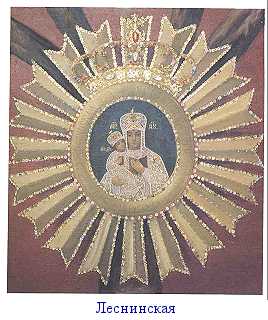Lesna icon of the Mother of God
In the late 17th century (1683), a herdsman saw a small icon in a bright halo of light among the branches of a pear tree in a dense forest near the village of Lesna in the environs of Grodno. Seized with terror, he fell on his knees and began to pray, then ran away and told his friend about what he had seen. The two of them hastened to tell the people of their village and the parish priest about the miraculous appearance. The icon was first brought to a peasant's house and then translated to the manor house of the local landowner. It became an object of veneration for numerous pilgrims. Subsequently Roman Catholics decided to gain possession of the shrine. They took it away from Orthodox Christians and Uniates and placed it in a newly-built Roman Catholic church at Lesna. In 1863, the Roman Catholic church was closed down and turned over to the local Orthodox community. By the turn of the century, the icon wrought more than five hundred miracles. The original miracle-working icon was carved from dark-red stone and set in a small silver frame and a large gilt frame in the shape of rays coming forth from it. Feast days: September 8/21 and 14/27.

